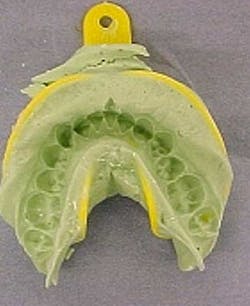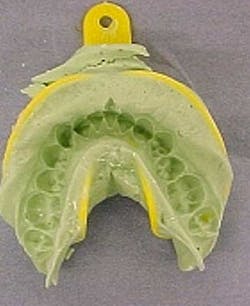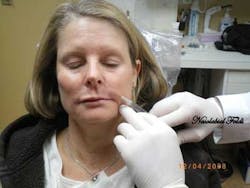Impression taking: common pitfalls and solutions
By Hollie Bryant, DA IIEditor's note:To find out if there are specific education or examination requirements for dental assistants to take impressions in your state, or if taking specific types of impressions are not allowed to be delegated to dental assistants, check with your state’s dental board or visit the State-Specific section of DANB’s website.How many impressions are you retaking? As a dental assistant, I have found that corners are often cut when taking impressions. Maybe over the course of time the “I’ve got it” attitude sets in. Maybe cutting corners is a way to save time, or maybe it’s lack of training. Often a simple step such as trying in the tray, underfilling, overfilling, or even failing to allow the material to sit for the required time prevents someone from taking an accurate impression. How does this affect our patients? How can we prevent retaking impressions? Here are a few common pitfalls that occur when taking impressions:Pitfall: The impression is removed from the mouth and there are teeth missing. Not all the teeth have been captured in the impression.
Solution: Trying the tray in the mouth and looking to see if the tray is the correct size is the most common error. Fill tray properly with impression material. Failure to get the proper amount of impression material will prevent an accurate impression.Pitfall: Removing the impression and all the teeth are present, but the gum tissue and bone has not been captured. Borders are not captured in the impression (missing half of the gum tissue).
Solution: There has not been enough impression material in the tray, the tray did not get seated properly, or the PVS, alginate, or alginate substitute set up too much before the tray was seated in the mouth.Pitfall: Runs and pulls at the gumline of the impression.
Solution: Not enough impression material in tray, or not seated properly (the tray should be seated parallel to the long axis of the teeth). Look at the back of the throat to know when to stop seating (when you see material oozing to throat, stop and wipe). Allow the material to set to completion, and do not remove the impression until the timer goes off.Pitfall: Air bubbles in impression after removing the tray.
Solution: Not enough impression material in tray, and keep tip of the material gun in the tray while loading material.Pitfall: Unbalanced or crooked impressions.
Solution: Hold over bicuspids to keep even pressure and steady (do not hold the handle of tray while it is setting up). Don’t have patient bite down on tray because this prevents even pressure on the tray.Pitfall: Removing tray improperly.Solution: Don’t use handle, and break suction over premolar area and pull tray down.Looking back at the impressions you have taken over the past few months, have you recognized any solutions that could prevent you from making these mistakes again? Take the extra seconds and get it right the first time. These pitfalls are costly in the treatment process. Patient time is lost, an unnecessary excess of material is used, wax-ups aren’t as good, temporaries take longer to make, and sometimes cases even have to be remade due to bad impressions. Do you think observing the pitfalls and finding the solutions can prevent these issues? Take the extra time now so that you can save time in the long run.Author bioHollie Bryant is a graduate of Bowman Gray Dental Assisting Program, and is the former chairside assistant for Dr. Ross Nash and clinical instructor and treatment coordinator at the Nash Institute. She is a member of the American Academy of Dental Office Managers, American Academy of Cosmetic Dentistry, North Carolina Dental Association, Academy of Comprehensive Esthetics, and the American Dental Assistants Association. She is the former editor-in-chief of Contemporary Dental Assisting magazine and currently serves on the advisory board for DentalCompare. She is on the editorial board of Dental Assisting Digest™ and Contemporary Product Solutions, and is a consultant for various dental manufacturers. Hollie has authored numerous manuscripts on clinical assisting and practice-management topics. She lectures for the NICHE Practice Seminars nationally on clinical and management topics, and travels for her independent consulting firm from practice to practice working with teams to increase customer service and profit, and implement effective systems. You may reach Hollie at [email protected].



